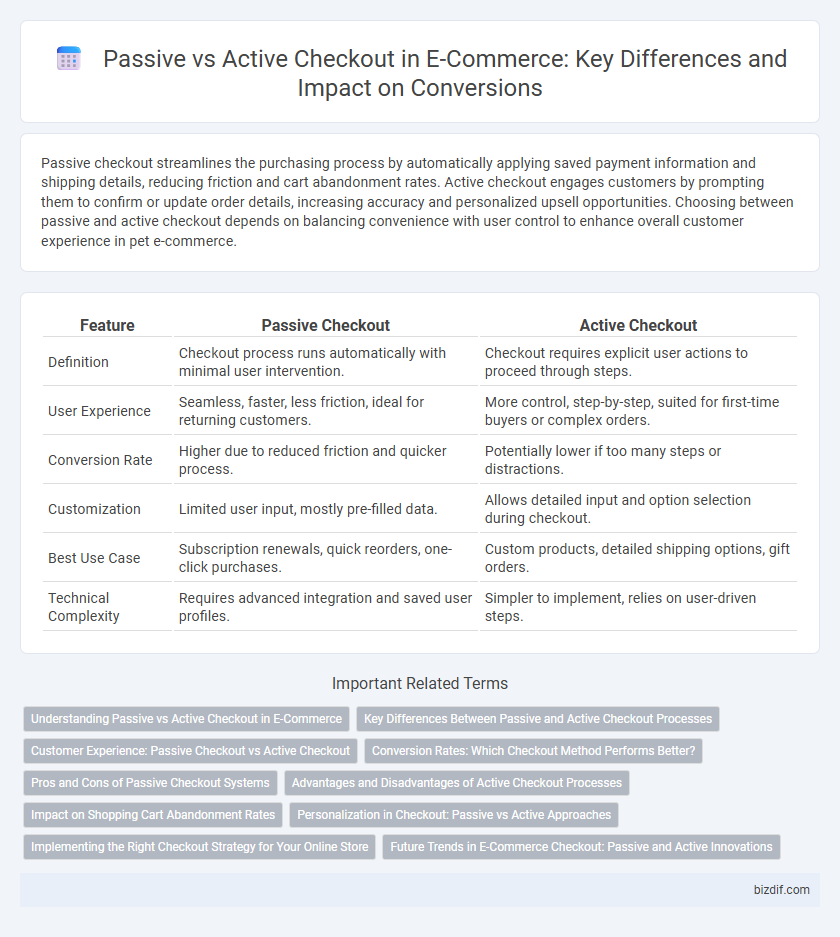Passive checkout streamlines the purchasing process by automatically applying saved payment information and shipping details, reducing friction and cart abandonment rates. Active checkout engages customers by prompting them to confirm or update order details, increasing accuracy and personalized upsell opportunities. Choosing between passive and active checkout depends on balancing convenience with user control to enhance overall customer experience in pet e-commerce.
Table of Comparison
| Feature | Passive Checkout | Active Checkout |
|---|---|---|
| Definition | Checkout process runs automatically with minimal user intervention. | Checkout requires explicit user actions to proceed through steps. |
| User Experience | Seamless, faster, less friction, ideal for returning customers. | More control, step-by-step, suited for first-time buyers or complex orders. |
| Conversion Rate | Higher due to reduced friction and quicker process. | Potentially lower if too many steps or distractions. |
| Customization | Limited user input, mostly pre-filled data. | Allows detailed input and option selection during checkout. |
| Best Use Case | Subscription renewals, quick reorders, one-click purchases. | Custom products, detailed shipping options, gift orders. |
| Technical Complexity | Requires advanced integration and saved user profiles. | Simpler to implement, relies on user-driven steps. |
Understanding Passive vs Active Checkout in E-Commerce
Passive checkout in e-commerce streamlines the purchasing process by minimizing user input, often through saved payment information and auto-filled forms to reduce friction and cart abandonment. Active checkout requires deliberate customer interaction, such as entering shipping details and payment data during the transaction, offering more control but potentially leading to higher drop-off rates. Understanding the balance between passive and active checkout methods is crucial for optimizing conversion rates and enhancing user experience on online retail platforms.
Key Differences Between Passive and Active Checkout Processes
Passive checkout allows customers to complete their purchase with minimal interaction, often by saving payment and shipping details for a faster transaction. Active checkout requires customers to manually input or confirm all information, providing more opportunities for customization and error correction. Key differences lie in user engagement level, speed of completion, and potential impact on conversion rates.
Customer Experience: Passive Checkout vs Active Checkout
Passive checkout enhances customer experience by minimizing interruptions, allowing shoppers to complete purchases seamlessly without extra steps, which reduces cart abandonment rates. Active checkout engages customers through interactive prompts and upsell offers, potentially increasing average order value but risking frustration if perceived as intrusive. Balancing these approaches depends on user preferences and product complexity, aiming to optimize conversion while maintaining a smooth, user-friendly transaction process.
Conversion Rates: Which Checkout Method Performs Better?
Passive checkout methods, which minimize user input by auto-filling information and simplifying steps, generally result in higher conversion rates due to reduced friction and quicker transaction completion. Active checkout processes, requiring customers to manually enter details and make explicit choices, often experience higher abandonment rates despite offering more control. Studies show that streamlined passive checkout options can increase conversions by up to 20% compared to traditional active checkouts, emphasizing the importance of user experience optimization in e-commerce.
Pros and Cons of Passive Checkout Systems
Passive checkout systems in e-commerce streamline the purchasing process by automatically gathering and pre-filling customer information, reducing friction and increasing conversion rates. However, reliance on passive data collection can raise privacy concerns, and errors in pre-filled information may lead to order mistakes and customer dissatisfaction. Despite these challenges, passive checkouts enhance user experience by minimizing manual input and speeding up transactions.
Advantages and Disadvantages of Active Checkout Processes
Active checkout processes in e-commerce enhance user engagement by requiring customers to manually input information, improving data accuracy and personalization opportunities. This approach reduces errors and fraud but may increase cart abandonment rates due to longer completion times and higher user effort. Businesses benefit from better customer insights while facing challenges in balancing user experience and data collection efficiency.
Impact on Shopping Cart Abandonment Rates
Passive checkout processes, characterized by minimal interruptions and streamlined form-filling, significantly reduce shopping cart abandonment rates by enhancing user experience and trust. In contrast, active checkout procedures, which often require multiple steps and explicit user actions, tend to increase friction, leading to higher abandonment rates. Optimizing the checkout flow with passive elements such as autofill, guest checkout, and saved payment options can improve conversion rates and overall e-commerce revenue.
Personalization in Checkout: Passive vs Active Approaches
Personalization in checkout enhances the shopping experience by tailoring options to individual preferences, increasing conversion rates. Passive checkout relies on pre-set templates with minimal user input, offering limited customization and often leading to generic experiences. Active checkout dynamically adapts in real-time, using data-driven insights to present personalized recommendations and payment options, resulting in higher customer satisfaction and reduced cart abandonment.
Implementing the Right Checkout Strategy for Your Online Store
Selecting the appropriate checkout strategy directly impacts conversion rates and customer satisfaction in e-commerce. Passive checkout minimizes friction by simplifying the purchase flow, often using guest checkouts and saved payment methods, while active checkout involves more user engagement such as detailed forms and account creation. Evaluating your target audience's preferences and the complexity of your product catalog will help determine whether passive or active checkout maximizes sales and reduces cart abandonment.
Future Trends in E-Commerce Checkout: Passive and Active Innovations
Future trends in e-commerce checkout emphasize seamless integration of passive checkout technologies like biometric authentication and AI-driven payment predictions to reduce friction and enhance security. Active checkout innovations focus on customizable user interfaces and real-time cart optimization, enabling shoppers to modify orders and select payment options dynamically. The convergence of passive and active checkout solutions promises a hybrid model that prioritizes speed, personalization, and fraud prevention, driving higher conversion rates and improved customer satisfaction.
Passive Checkout vs Active Checkout Infographic

 bizdif.com
bizdif.com